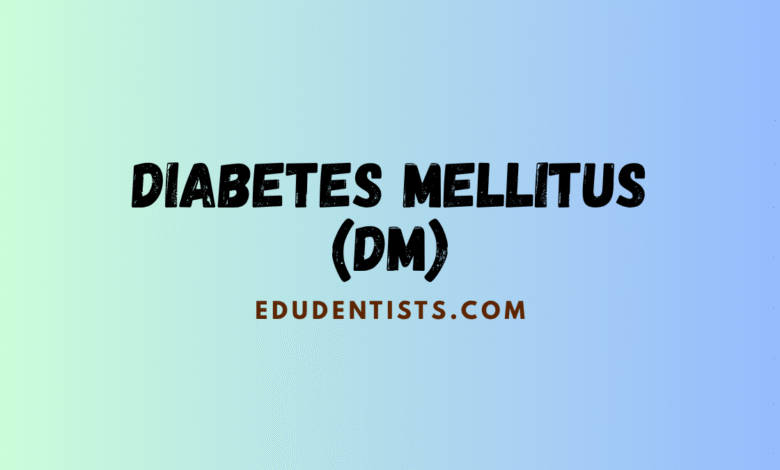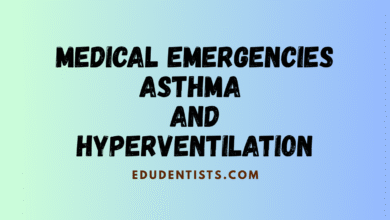
Diabetes Mellitus (DM)
🌡️ Diabetes Mellitus (DM) – Complete Guide for Dental Professionals 🦷💉
📌 Focus Keyphrase: Diabetes Mellitus
📌 Meta Description: Comprehensive and mobile-friendly guide to Diabetes Mellitus including classification, clinical signs, complications, and dental management. Features insulin types, acute vs. chronic issues, and prevention strategies.
📘 Overview
Diabetes Mellitus (DM) is a chronic metabolic disorder characterized by high blood glucose levels due to impaired insulin production or utilization. Insulin, produced by the pancreas 🩺, helps transport glucose into the cells. When this function is disrupted:
- 📈 Glucose accumulates in the blood (hyperglycemia)
- 🧪 Spills into urine (glucosuria)
- 💧 Causes excessive urination (polyuria), thirst (polydipsia), and weight loss 🏃♂️
Without energy from glucose, the body shifts to metabolizing fat and proteins, leading to further complications like ketoacidosis 😵💫.
🔍Classification of Diabetes Mellitus
The American Diabetes Association (ADA) defines diabetes based on:
- 🔬 Random glucose ≥ 200 mg/dL with symptoms (polyuria, polydipsia, weight loss)
- 🍽️ Fasting glucose ≥ 126 mg/dL
- ⏱️ 2-hour postprandial glucose ≥ 200 mg/dL
🧪 Major Types of Diabetes
- 🧠 Type 1 Diabetes Mellitus (T1DM)
- 🧬 Autoimmune destruction of β-cells → absolute insulin deficiency
- 🧒 Common in children/young adults (peak: 10–14 yrs)
- ❗ Sudden onset, ketosis-prone, insulin-dependent
- 📉 No circulating insulin, high glucagon
- ⚖️ Type 2 Diabetes Mellitus (T2DM)
- 🧓 Most common in adults
- 💉 Insulin levels are normal/high but tissues resist its effect
- 🧂 Strong link to obesity and sedentary lifestyle
- 🧬 Insulin resistance + inadequate secretion
- 🤰 Gestational Diabetes Mellitus
- 🤱 Arises during pregnancy
- 🧪 Diagnosed via abnormal OGTT
- 🔺 Risk for perinatal complications
- May revert postpartum or persist as T2DM
- ⚠️ Impaired Glucose Tolerance (IGT)/Fasting Glucose
- 🩸 Fasting glucose: 100–125 mg/dL
- 🍭 OGTT: 140–199 mg/dL
- 💊 Pre-diabetic state, increased cardiovascular risk
🔬 Clinical Manifestations 📉📈
🔺 Hyperglycemia (High Blood Sugar)
- 🧑⚕️ Often asymptomatic in T2DM
- 📋 Detected during routine exams or after vascular events
- Classic triad:
- 💧 Polydipsia
- 🍔 Polyphagia
- 🚽 Polyuria
- ⚠️ Advanced signs: fatigue, blurred vision, nausea, deep breathing (Kussmaul’s), fruity breath 🍓, dry skin 🔥
🔻 Hypoglycemia (Low Blood Sugar)
- ⚠️ More common than hyperglycemia
- 🧠 CNS symptoms: confusion, mood changes, bizarre behavior
- 💪 SNS response: sweating, cold skin ❄️, tachycardia, hunger
- 🧃 Treated with sugar or glucagon injections 💉
💥Acute Complications 🚨
- 🔴 Hypoglycemia: Most immediate danger in the dental chair
- 🔥 Diabetic Ketoacidosis (DKA): More common in T1DM
- 💧 Hyperosmolar Hyperglycemic State (HHS): More common in T2DM
⏰ Rapid recognition and intervention are critical to prevent coma or death.
🩺 Chronic Complications 💣
| Affected System 🧍♀️ | Complication 💢 |
|---|---|
| 🧠 Nervous System | Neuropathy |
| ❤️ Cardiovascular | Atherosclerosis, MI |
| 👁️ Eyes | Retinopathy, cataracts |
| 🧫 Kidneys | Nephropathy, renal failure |
| 👄 Oral | Gingivitis, periodontitis, caries |
| 👶 Pregnancy | Stillbirths, congenital defects |
| 🦵 Skin | Fungal infections, pruritus |
🛠️ Control & Management 💊
Type 1 Diabetes (T1DM) 💉
- 📦 Requires lifelong insulin therapy
- 🔁 Options:
- 🗓️ Classic regimen: fixed insulin & meals
- 📌 Flexible MDI (Multiple Daily Injections): Adjust doses based on activity/food
- 🧠 Insulin Pumps: Basal-bolus-supplemental insulin delivery
Type 2 Diabetes (T2DM) ⚖️
- 🥗 Diet, exercise, weight loss
- 💊 Oral hypoglycemics: sulfonylureas (e.g., glipizide), metformin
- 💉 Insulin added when oral therapy fails
- 🌿 Pramlintide (Symlin) enhances control without weight gain
📊 Monitoring
- 🧪 Frequent blood glucose monitoring
- 🩸 Devices now offer plasma-equivalent readings
- ⌚ Non-invasive monitors (e.g., GlucoWatch) available
🧩 Predisposing Factors 🧬
- Type 1:
- 🧬 Genetic susceptibility
- 🦠 Viral triggers: rubella, coxsackievirus
- 🛡️ Autoimmune β-cell destruction
- Type 2:
- 🧬 Complex genetic + environmental interaction
- 🍔 Obesity, sedentary lifestyle
- 🧪 Insulin resistance + secretion defects
🦷 Dental Considerations for Diabetic Patients 🪥
- 📋 Evaluate for acute complications before treatment
- 🦷 Be cautious with invasive procedures in poorly controlled DM
- 🛡️ Stress reduction and good infection control are key
- 📆 Morning appointments are best
- 💉 Ensure emergency glucose is on hand
📊 Infographic: Insulin Types & Regimens 🧬💉
| Insulin Type | Onset | Peak | Duration | Notes |
|---|---|---|---|---|
| ⚡ Rapid-Acting | 15 min | 1 hr | 2–4 hrs | Taken before meals |
| 💧 Short-Acting (Regular) | 30–60 min | 2–3 hrs | 5–8 hrs | Meal-time insulin |
| 🌙 Intermediate (NPH) | 1–3 hrs | 4–12 hrs | 12–18 hrs | Usually 2x daily |
| 🌕 Long-Acting | 1–2 hrs | Minimal | 24+ hrs | Once daily, steady effect |
📦 Combination Therapy: MDI (3–4 daily injections) or insulin pump for tight control.
🚫 Prevention & Early Detection 🧠
- 📋 Medical history review at dental visits can detect undiagnosed DM
- 📉 Monitor for risk indicators:
- 👶 Large birth weight babies
- 🧓 Age >40
- ⚖️ Obesity
- 🧬 Family history
🏁 Final Thoughts
Diabetes Mellitus is a lifelong condition that demands daily attention, education, and lifestyle management. With advancements in insulin delivery 🧬 and self-monitoring 📟, patients can achieve near-normal glycemic control and reduce complications.



